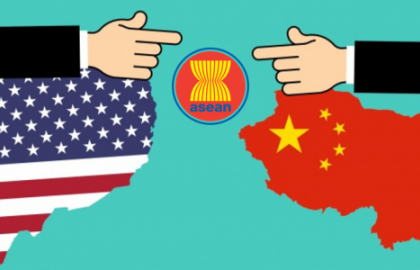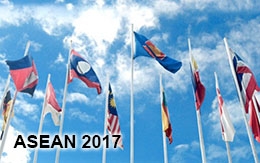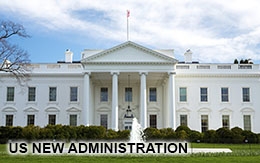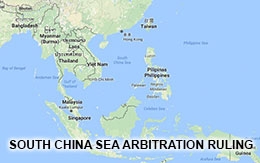Big Power Rivalry, ASEAN’s Dilemmas and Strategic Situation in the South China Sea
While Southeast Asia has been looking for the post-pandemic recovery the regional strategic situation continues to be defined by the rising tensions of big powers, primarily of China and the USA. These tensions are not new and emerge from the pre-pandemic years of growing regional complexity and conflicting visions of the regional order. With this international context in mind the paper aims to assess the South China Sea as a two-level problem. The dynamics at the first level is mainly defined by the ASEAN member states and at the second one – by China and the USA.

Introduction
ASEAN, an amalgam of small and middle-range states of Southeast Asia, has been deliberately distancing itself from the debate on the hard / structural security challenges. For the past three decades, Association’s primary attention has been focused on the ways to ensure and maintain a proper balance of power between the extra-regional actors in such a way that it could be conducive to its development (Katsumata 2009).
Existing literature extensively reflects this search for instruments to manage the great power relations in the region, but mainly in the political and economy domain. However if one looks at the protagonists of these great power relations, the obvious fact would be that they include all important stakeholders in the ongoing strategic stability debate, i.e. the USA, China, Japan, Russia, India, and Australia. The USA and Russia are the main interested parties in this debate. China stays outside the Soviet-American agreements in the sphere of arms control but its (un)willingness to get engaged in the new generation of strategic stability negotiations defines today a key variable in this sphere. Moreover, while Southeast Asia has been looking for the post-pandemic recovery (the agendas of three “ASEAN chairmanships” – ASEAN itself, APEC and G20 clearly reflect this aspiration) the regional strategic situation continues to be increasingly defined by the rising tensions between big powers, primarily of China and the USA. These tensions are not completely new and emerge from the pre-pandemic years of growing regional complexity and conflicting visions of the regional order embodied in a dozen or so of Indo-Pacific strategies.
Against this background this paper assesses the regional security situation in general and the South China Sea issue, in particular, as a two-level problem. The dynamics at the first (lower) level is mainly defined by the ASEAN member states and at the second one (where the regional-global nexus is most visible) – by China and the USA.
ASEAN’s perceptions of security and security-related institutions
Key drivers of ASEAN’s approach to regional security traditionally included an aspiration for an optimal balance of external powers and, most recently, the struggle to keep ASEAN central to all large-scale discussions concerning the state of the regional affairs, including security. In this logic of ASEAN centrality, i.e. ability to organize a wider network of regional cooperation, the 1994 witnessed the emergence of the ASEAN Regional Forum (ARF). In 2005, the East Asian Summit started to operate as a yearly high-level meeting of all ASEAN member states and six key dialogue partners (China, Japan, South Korea, India, Australia, and New Zealand). In 2010, EAS expanded to include Russia and the USA. This same year Vietnam, the then ASEAN chair, initiated the ASEAN Defense Ministers Meeting Plus (ADMM+, the instrument for uniting defense ministers of ASEAN and the same ten dialogue partners who also participated in the EAS).
Thus, ASEAN started the second decade of this century with three key instruments for security cooperation, namely the ARF, EAS and ADMM+. While the first one (right according to its name) became mainly a platform for the exchange of opinions, the second one stayed paralyzed by controversies between the big powers. In these circumstances, the perspectives of ADMM+ looked brighter because right from the start it took a much more practical rather than philosophical approach to security and focused on the capacity building (i.e. in the sphere of mine clearing in Indochina) and most pressing transnational security threats to the region (like terrorist activities or maritime challenges)[i].
None of these three instruments, however, implied even a vague opportunity to discuss seriously the regional structural security issues and challenges (i.e. existential / hard security challenges related to strategic stability, nuclear non-proliferation, security block divisions, territorial conflicts). Moreover, never the strategic stability issues appeared in the recent expert assessments as significant challenges for Southeast Asia. Thus, the 2021 State of Southeast Asia Survey Report indicated that top three challenges facing Southeast Asia included the COVID-19 pandemic, unemployment and economic recession and socio-economic gaps and rising income disparity and the 2020 Survey almost completely repeated these concerns.
Geo-economic understanding of big power rivalry
One can explain the logic of ASEAN’s non-focusing on the structural dimension of the great powers’ rivalry in the Asia-Pacific by the Association’s mostly geo-economic understanding of the nature of this rivalry. Even the conflict with China over the islands in the South China Sea so far remains more as an unpleasant background of still booming economic relations (in 2020, ASEAN became China’s number one trading partner) rather than a looming large immediate security threat. This conflict, indeed, already spurred the regional arms race but at the same time continued to fluctuate between escalations and setbacks. ASEAN member states used to perceive the rising Sino-US rivalry also mainly in the geo-economic terms, reflecting on their non-willingness to take sides or to experience the effects of Sino-US decoupling (which could have indeed taken decades if the international relations in the global scale continued to develop in the evolutionary way). Since the nature of great power rivalry seemed to lay in the geo-economic domain the response also came from the geo-economic front, that was turning to Japan or the EU and in some cases – to Russia – as ‘third forces’. In other words, the great power rivalry and the conflicting elements of regional order visions looked unpleasant (see Table 1) but manageable.
Table 1. Three visions of regional order (before 2022): assessment of advantages and shortcomings
|
Organizing Actor |
USA |
China |
ASEAN |
|
Advantages |
Securing (historically) relatively stable region in view of some regional actors Providing access to the US market and technologies for the US partners and allies (at different degrees) | An economic chance, including the less developed countries to ensure a rapid economic development | Inclusiveness, moving the speed which fits all Cognitive regionalism rather than functional |
|
Shortcomings |
Interventionism Seeking universal solutions at the expense of regional specifics | A threat of potential conflict Non-transparent nature A necessity to accept Chinese national interests as a priority while leaving own national interests on the periphery | A lack of own economic and political resources, hence a constant necessity to rely on external powers |
Source: compiled by the author.
Another reason came from the ASEAN member states’ relative confidence in their success of creating Southeast Asia as a ‘neutral’ region. In 1971, ASEAN, though being itself a product of Cold War and situated in the Cold War conditions, adopted a Declaration, which proclaimed Southeast Asia a Zone of Peace, Freedom and Neutrality (ZOPFAN). Its main provision was about consolidated efforts of ASEAN five founding states to achieve the recognition of Southeast Asia as a neutral zone free from external influence. This approach was later on developed in the Treaty of Southeast Asia Nuclear Weapon-Free Zone (SEANWFZ Treaty) signed in 1995 in Bangkok. By 2001, the Treaty became fully effective for ten ASEAN member states. At the same time none of the five nuclear-weapon states so far signed a protocol attached to the Treaty.
Game changers
There are several game changes, which might soon make ASEAN aware of the structural security issues more than before. There are now additional drivers of the regional arms race in action, among which are the changing constellation of power in the Northeast Asia (and potentially in Southeast Asia) as a result of the 2022 conflict in Ukraine and shifts in the regional security architecture caused by the appearance of such minilateral frameworks as AUKUS.
On the Indo-Pacific front, the appearance of AUKUS (trilateral grouping consisting of Australia, the UK and the USA) in October 2021 and the prospect (so far, though, quite remote) of Australia’s acquiring the nuclear-powered submarines raised serious concerns among ASEAN member states. In Northeast Asia, in the late February 2022 former Japanese Prime Minister Shinzo Abe stated that Japan should consider hosting US nuclear weapons. With Russia and China moving closer together Tokyo now has to face two adversaries in the region. Both developments create prerequisites for regional security transformations, which go well beyond ASEAN-centered regional institutions abilities to cope with.
At the global level, US more outspoken definition of its rivals – Russia as an ‘immediate challenge’ and China as ‘the only competitor with both the intent to reshape the international order and … the power to advance that objective’ – in the 2022 National Security Strategy defines much of the logic for the new directions of Asia Pacific regional order development as well. With geo-economic visions of the regional order giving the way to the rising geopolitical rivalry (reflected also in the July 2022 crisis over Speaker of the United States House of Representatives Nancy Pelosi’s visit to Taiwan) South China Sea issue may become an offspring of the regional tensions. In this case the two level nature of the conflict in which one level represent the interaction of mainly regional actors and another one structurally represent global dynamics will significantly limit ASEAN, its member states involved in the conflict and ASEAN-related security institutions in their ability to influence the way the conflict develops (see Table 2).
Table 2. Shifts in the regional order organization under the geopolitical rivalry paradigm
|
Organizing Actor |
USA |
China |
ASEAN |
|
Changes vis-à-vis points reflected in table 1 |
Providing security for allies at the expense of other regional actors through bilateral alliances and exclusive minilateral frameworks Access to market and technologies is limited, restrictive measure become an instrument of geoeconomic war |
Emergence of countries closely connected to China economically (potentially – technologically) |
Crisis of inclusivity amidst efforts to balance and keep relative neutrality |
Source: compiled by the author.
Conclusion
Even though the structural security issues might well be soon catching up with ASEAN (and the South China Sea) the ASEAN-centered regional institutional network is poorly equipped for dealing with such issues. Moreover, the predominantly geo-economic vision of the big powers’ rivalry distorts ASEAN member states’ ability to take seriously the structural security challenges related to this rivalry. While ASEAN Regional Forum and East Asian summit continue to stagnate as region-wide platforms for security cooperation, a more practical oriented ADMM+ may also face difficulties in its operations due to intramural controversies over political crisis in Myanmar or US-Russia and US-China contradictions. The conflict in Ukraine (and Europe), decoupling of Russia and so-called ‘collective West’ reinforces already visible for a decade US-China contradictions and their move toward increased geopolitical rivalry.
As for the ASEAN-centered institutions’ ability to revert or manage these trends, one can conclude that the experience of ASEAN’s collective action, a necessity to get along together with many internal and external limitations made ASEAN able to formulate a very rational view of regional (and global) order. Its core includes: inclusiveness, acceptance of the nation-state system (in contrast with the Middle East), respect to the international law and norms. The West is seen as an important actor but its interventionism is rejected. China is perceived as an economic chance but not as a regionally organizing force. Such an approach to regional order has reasonable grounds but the abilities of ASEAN member states to advance it further in practices seems increasingly problematic.
References
Emmers, Ralf and See Seng Tan (2011) “The ASEAN Regional Forum and Preventive Diplomacy: Built to Fail?”, Asian Security 7, no.1, p.44-60.
Katsumata, Hiro (2009). ASEAN’s Cooperative Security Enterprise: Norms and Identities in the ASEAN Regional Forum. Basingstoke: Palgrave.
Seah, S. et al. (2021) The State of Southeast Asia: 2021. Singapore: ISEAS-Yusof Ishak Institute.
Seah, S. et al. (2022) The State of Southeast Asia: 2022. Singapore: ISEAS-Yusof Ishak Institute.
Tan, See Seng (2017) “A Tale of Two Institutions: The ARF, ADMM-Plus and Security Regionalism in the Asia Pacific”, Contemporary Southeast Asia, Vol.39, No.2, pp.259-264.
Tan, See Seng (2019) “Is ASEAN Finally Getting Multilateralism Right? From ARF to ADMM+”, Asian Studies Review, Vol.44, Iss.1, pp.28-43.
US National Security Strategy (2022). URL: https://www.whitehouse.gov/wp-content/uploads/2022/10/Biden-Harris-Administrations-National-Security-Strategy-10.2022.pdf (accessed November 15, 2022)
[i] For the scholarly debate on these issues see, for example: Emmers and Tan 2011; Tan 2017; Tan 2019.
Ekaterina Koldunova is the Director at the ASEAN Centre, Moscow State Institute of International Relations, the MFA of Russia










